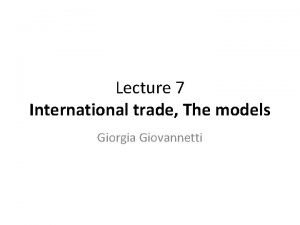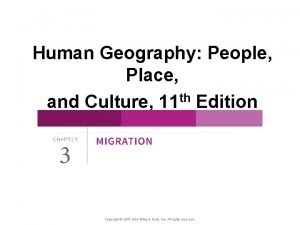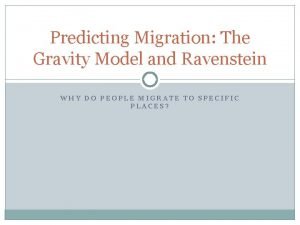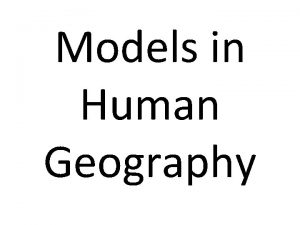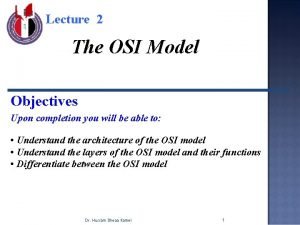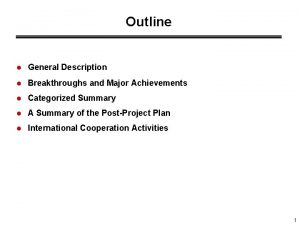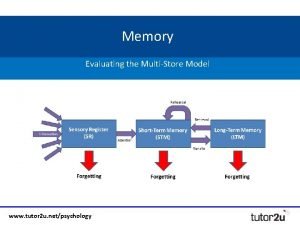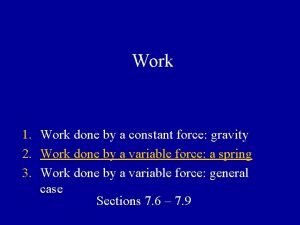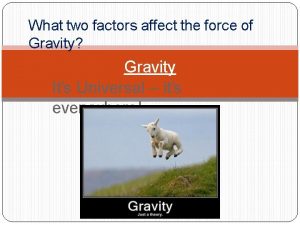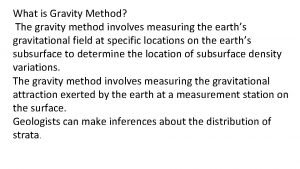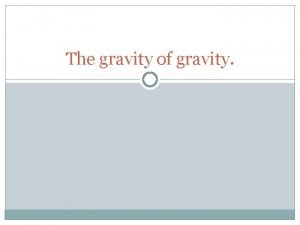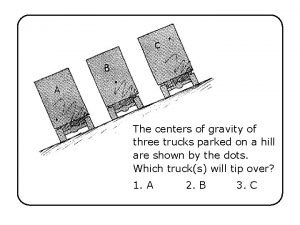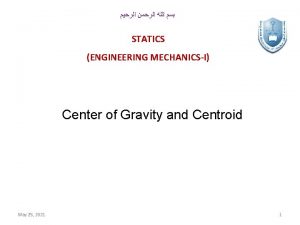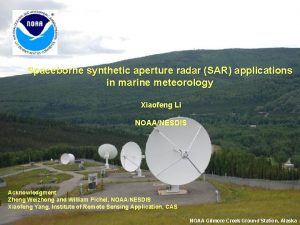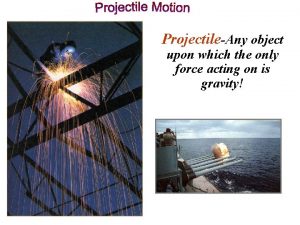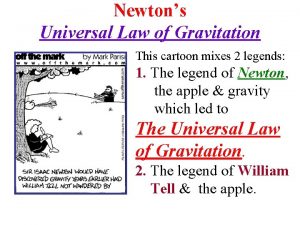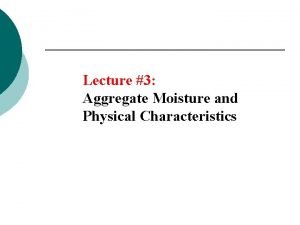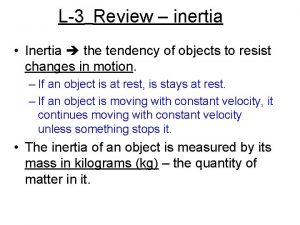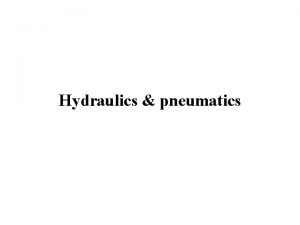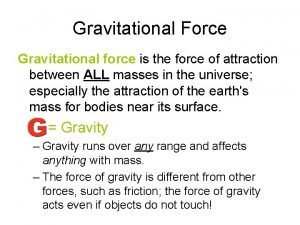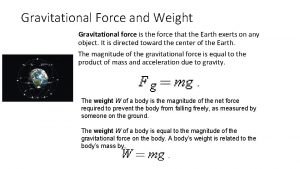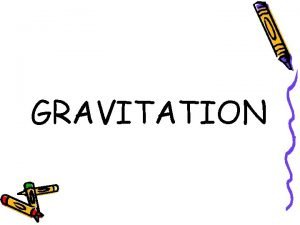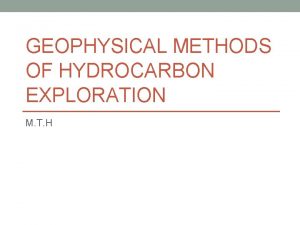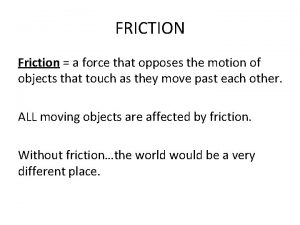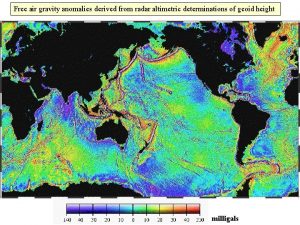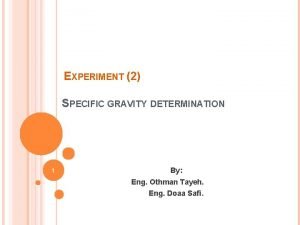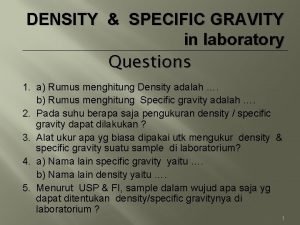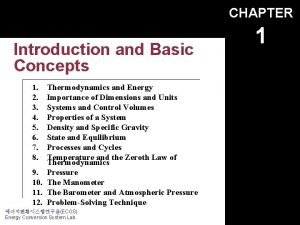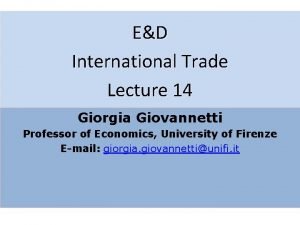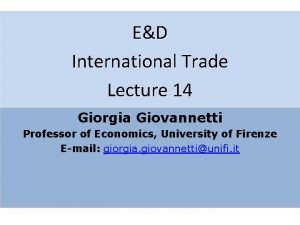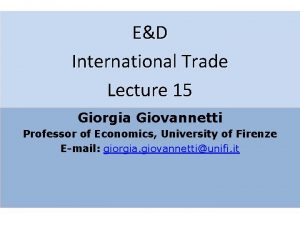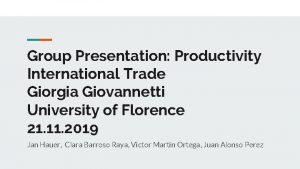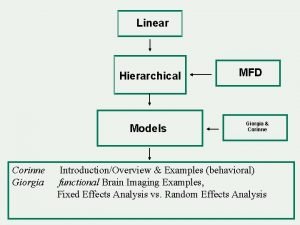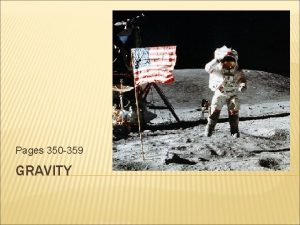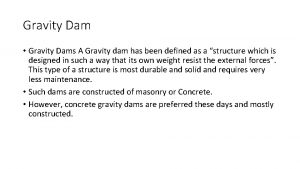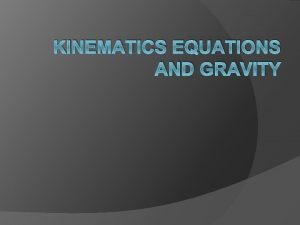Lecture 6 Gravity model Giorgia Giovannetti Outline Summary























































































- Slides: 87

Lecture 6 Gravity model Giorgia Giovannetti

Outline • Summary of last lecture • The gravity model • Challenges of heterogenous firms (empirics)

Summary: Ricardian Model in pills Comparative Advantage (technology based) - distinct from absolute advantage (Smith) - all countries can compete/trade (if wages low enough) - all can gain from trade - smaller countries tend to “gain more” But - complete specialisation - no internal income distribution

The H-O model in pills, 1 • The Heckscher-Ohlin model, in which two goods are produced using two factors of production, emphasizes the role of resources in trade. • A rise in the relative price of the labor-intensive good will shift the distribution of income in favor of labor: • The real wage of labor will rise in terms of both goods, while the real income of landowners will fall in terms of both goods. • For any given commodity prices, an increase in a factor of production increases the supply of the good that uses this factor intensively and reduces the supply of the other good. • The Heckscher-Ohlin theorem predicts the following pattern of trade: • A country will export that commodity which uses intensively its abundant factor and import that commodity which uses intensively its scarce factor.

The H-O model in pills, 1 • The owners of a country’s abundant factors gain from trade, but the owners of scarce factors lose. • In reality, complete factor price equalization is not observed because of wide differences in resources, barriers to trade, and international differences in technology. • Empirical evidence is against the Heckscher-Ohlin model (Leontief paradox). • Most researchers do not believe that differences in resources alone can explain the pattern of world trade or world factor prices.

The Leontief Paradox • In 1954 and 1956 Leontieff run two tests of Heckscher-Ohlin. Samuelson theory. • In the first test (1954) he uses American data from the 1947 inputoutput tables with 200 industries aggregated in 50 sectors. • He computes direct and indirect requirements of labour and capital for the production of 1 million dollars worth of US export and for the production of 1 million dollars worth of competivive imports (import replacement). • Then he computes the capital/labour ratio of US import and export in order to test the H-O-S theory under the hypothesis that the USA is a “Capital Abundant” country

The Leontief Paradox • Expected results: Assuming that the USA have a relative abundance of capital, the USA should export capital intensive goods and should import labour intensive goods • Results: just the opposite! The USA exports labour intensive goods! • Explanations: American workers are more efficient so that American labour is more valuable (example: 1 hour of American work is worth 2 hours of foreign work) As a consequence, the USA is actually better endowed with labour than other countries; but Leontieff does not explain why American work should be more efficient • In 1956 Leontieff repeats his test using the same 1947 input-output tables but taking in account 192 industries and the 1951 US trade composition The “paradox” shows up again even if it is attenuated • US export appears to be still labour intensive

Summary: Monopolistic Competition (New Trade Theory) in pills • Trade can result from increasing returns or economies of scale, that is, from a tendency of unit costs to be lower at larger levels of output. • Economies of scale can be internal or external. • The presence of scale economies leads to a breakdown of perfect competition. • Trade in the presence of economies of scale must be analyzed using models of imperfect competition. Krugman (1979, 1980); Helpman and Krugman (1985) in HO trade models Uses “love of variety” preferences – e. g. Dixit-Stiglitz Goods are differentiated by firm, while increasing returns at the firm level limit product variety

Summary: New Trade Theory in pills • In monopolistic competition, an industry contains a number of firms producing differentiated products. • Intraindustry trade benefits consumers through greater product variety and lower prices. • In general, trade may be divided into two kinds: • Two-way trade in differentiated products within an industry (intraindustry trade). • Trade in which the products of one industry are exchanged for products of another (interindustry trade). • External economies give an important role to history and accident in determining the pattern of international trade. • When external economies are important, countries can conceivably lose from trade.

Gravity in pills • Distance matters for trade • Consistent with both new trade theory and old trade theory • Theory has helped refine the gravity relationship • Gravity can be used to test other hypotheses even if we don’t know what drives gravity

90% of world trade is by sea; Shipping Routes

Suez Channel, 1869, huge cut in costs, recently the channel has been doubled (2015)

Panama Channel, 1914

If channels/infrastructures trigger trade by sea, Pirates discourge it…

Seaports are a physical manifestation of the global trade of goods

Shanghai

Cost of trade decreased

Increase role for containers "One of the most significant, yet least noticed, economic developments of the last few decades… Containerization slashed the cost of transporting goods around the world and made the boom in global trade possible”

Containers, increase in less than 50 years



Who trades with whom? The gravity model

The gravity model

The gravity model • Newton’s Law: Any two bodies in the universe attract each other with a force that is directly proportional to the product of their masses and inversely proportional to the square of the distance between them.

The gravity model • The gravity model also explains international trade! • Size (GDP) and distance determine bilateral trade across countries • Distance matters for trade • As mentioned above, this model is consistent with both new trade theory and old trade theory • Theory has helped refine the gravity relationship • Gravity can be used to test other hypotheses even if we don’t know what drives gravity

From Newton… • Newton’s “Law of Universal Gravitation” (1687): The attractive force (Fij) between i and j • Mi, Mj are the masses • D is distance between two objects • G is gravitational constant Mi F D Mj

To today’s Economists…. • Model many social interactions (migration, tourism, trade, FDI) • Fij is the flow from i to j • M’s are measure of economic mass • D is the distance

Estimation of the Gravity Equation • Take logs:

The Role of economic mass • Usually measured using GDP • Most theoretical explanations predict coefficient equal to one • Estimates often not significantly different from 1, but range is from 0. 7 to 1. 1

The role of distance • Distance usually measured using great circle distance based on latitude and longitude • Head (2000) averages results from 62 regressions in eight papers, for sample years ranging from 1928 to 1995 • Average distance effect is 1. 01 • Doubling distance halves trade

Distance and trade costs • Trade costs: • Direct (transport) • Indirect (government policy; language) • Is distance just capturing the effect of trade costs (acting as a proxy) or does it play an additional role?

Size Matters: The Gravity Model (cont. ) • In fact, the size of an economy is directly related to the volume of imports and exports. • Larger economies produce more goods and services, so they have more to sell in the export market. • Larger economies generate more income from the goods and services sold, so people are able to buy more imports. 2 -32

“The gravity model” • Gravity Law: Holding constant the product of two countries’ sizes, their bilateral trade will, on average, be inversely proportional to the distance between them.

The gravity model

The gravity model

The gravity model • Has globalization brought the death of distance?

The border effect • Trade between countries is harder than trade between regions within a country • Economists have coined how harder it is “the border effect”, as it involves crossing an international border • The border effect is the empirical regularity that trade is much higher within countries than across country borders

The border effect • Example: • Do US States and Canadian provinces trade as much between them when goods have to cross the border? • We can answer this question by looking at how much Canadian provinces and US States at similar distances trade with British Columbia


The border effect Crossing the border reduces trade by 80%

The border effect • Why do borders reduce trade? • • • Tariffs Administrative barriers (docs) Currency exchange Cultural barriers …? • The border effect can also be thought of as a home bias, i. e. a preference for home goods over foreign ones


Extra readings • Head, K. and Mayer, T. (2013), What separates us? Sources of resistance to globalization. Canadian Journal of Economics, 46: 1196– 1231.

More on gravity models • Countries distance from the Rest of the World also matters for their bilateral trade Rest of the World Country A Country B

Estimated gravity equation. . . • Normal trade with Resistances ln (Tradeij) = C + a ln(GDPi) + b ln(GDPj) + +c ln(distanceij) + d ln(Remoteness)i + + e ln(Remoteness)j+ uij In applied exercises the Remoteness term is calculated as: Sumk distancekj/GDPk

Estimated gravity equation. . . Normal Trade • Normal trade normalizing for a third country ln (Tradeij /Tradekj) = C+ a ln(GDPi/GDPk) + c ln(distanceij/distancekj) + uij

“Augmenting” the gravity equations • Income per capita (higher income countries trade more) • Adjacency • Common language, colonial links • Institutions, infrastructures, labour flows, . . . • Surprisingly, bilateral tariff barriers often missing!!!

“Augmenting” gravity model • Traditional approach to evaluate the impact of RTAs: Trade creation and trade diversion ln (Tradeij) = a ln(GDPi) + b ln(GDPj) + +c ln(distanceij, , adjacency, language. . ) + d (Dummy i) + + e (Dummy j) + g (intra-RTAij)+ h (extra-RTAij) + uij • IMPORTANT the gravity model does not estimate welfare effects

“Augmenting” gravity model • . . . the problem of endogeneity of FTA (Baier and Bergstrand, 2005) dln Trade. Shareij, t-(t-1) = b d. RTAij, t-(t-1) + d Dummy i, t-(t-1) + e Dummy j, t(t-1) + uij n*t Country-and-time fixed effects

Weak points of the Gravity Model • does not determine endogenously which country produces which goods, • does not tell us how trade will affect factor incomes, • requires various ad hoc adjustments for fitting to data. • For empirical estimation, the concept of “distance” must be interpreted not just in the physical sense but in an economic sense. • Distance within a country matters much less than distance across borders, having a common border or not makes a difference, preferential trade agreements and common currencies matter, etc.

The concept of a country’s competitiveness is often associated with its trade performance…. • Aggregate indicators – e. g. Unit labour costs (ULC), the exchange rate - are used as proxy for competitiveness. But it is important to go beyond costs factor and aggregate indicators: also non price factors matter (tastes/quality). Also we can focus on trade competitiveness • Export market shares aims at capturing structural gain or losses in competitiveness. At macro level, indicators in this category track the export performance of a country/sector. • Importance of firm level and cross border perspective • Micro-founded indicators are based on intensive (how much) and extensive (how many) margins of trade • Productivity is the cornerstone dimension of firm heterogeneity – productivity threshold by international status (exporters are more productive etc) vs specificities of firms below/above thresholds

Competitiveness is a multifacet concept Some Indicators used to measure trade competitiveness • 5 year change in export market shares; problem: market shares are unrelated to competitiveness in a world chracterized by GVCs • Relative trade balance; problem: a negative trade balance is not necessarily a bad sign • Revealed comparative advantage • Current account as % of GDP; problem: endogeneity; also, includes non trade related components • Other (measurable) aspects are: price and costs competitiveness (real effective exchange rate; unit labour costs; price cost margins; ) Innovation and technology (non price competitiveness); firm dynamics; Global value chains

Demand also matters. . Different opportunities in different areas, 2016 -2017 (estimates, prometeia)

It would be important for SMEs to know who are the competitors • Data for this are difficult to find • In Italy model ICE-Prometeia does this (and could be possibly used).

Competitiveness indicators • The real effective exchange rate q = E P / P* where: E = nominal effective exchange rate (foreign currency per unit of domestic currency) P = index of domestic prices P* = index of foreign prices



Competitiveness: changes in RER An increase is a loss of competitivenness

Globalization index The KOF Index of Globalization measures the three main dimensions of globalization: economic; social; and political. 1970 2008 http: //globalization. kof. ethz. ch/

Some Global Ranking: • Global Competitiveness Index (GCI) – published annually by the WEF. It captures the microeconomic and macroeconomic foundations of national competitiveness, including structural factors. The GCI considers 12 main determinants of competitiveness called “pillars”: institutions, infrastructure, macroeconomic stability, health and primary education, higher education and training, goods market efficiency, labor market efficiency, financial market sophistication, technological readiness, market size, business sophistication, and innovation. • The World Competitiveness Index (WCI) – published by the IMD, uses 329 criteria for evaluating enhancing factors for doing business and social welfare. It elaborates a country profile measuring macroeconomic performance, governmental and private sector efficiency and infrastructure levels for 57 countries. • The Doing Business Index – published annually by the World Bank, investigates the business environment in countries, considering regulations that enhance business activity and those that constrain it. Indicators: starting a business, dealing with construction permits, employing workers, registering property, getting credit, protecting investors, paying taxes, trading across borders, enforcing contracts, and closing a business etc

The Global Competitiveness Report • World Economic Forum http: //www. weforum. org • Global competitiveness Index http: //www 3. weforum. org/docs/WEF_Global. Competitiveness. Report_2012 -13. pdf

The Global Competitiveness Index The Framework Key for factor-driven economies Key for efficiency-driven economies A. Basic Requirements B. Efficiency Enhancers Key for innovation-driven economies C. Innovation & Sophistication Factors 1. Institutions 5. Higher education and training 11. Business sophistication 2. Infrastructure 6. Goods market efficiency 12. Innovation 3. Macroeconomic environment 7. Labor market efficiency 4. Health and primary education 8. Financial market development 9. Technological readiness 10. Market Size

The Global Competitiveness Index 2010 Top 20 and selected economies ranking Rank (Out of 139) 1 2 3 4 5 6 7 8 9 10 11 12 13 14 15 16 17 18 19 20 Economy Switzerland Sweden Singapore United States Germany Japan Finland Netherlands Denmark Canada Hong Kong SAR United Kingdom Taiwan, China Norway France Australia Qatar Austria Belgium Luxembourg Score 5. 6 5. 5 5. 4 5. 3 5. 2 5. 1 5. 0 Rank (Out of 139) 26 27 29 30 31 34 36 44 48 49 50 51 54 58 60 61 63 66 113 134 Economy Malaysia China Ireland Chile Iceland Oman Czech Republic Indonesia Italy Montenegro Malta India South Africa Brazil Slovak Republic Turkey Russian Federation Mexico Tanzania Burkina Faso Score 4. 9 4. 8 4. 7 4. 6 4. 4 4. 3 4. 2 3. 6 3. 2

The Global Competitiveness Index Canada comparison with France

The Global Competitiveness Index Canada comparison with United Kingdom

The Global Competitiveness Index Canada comparison with developed countries: United States

Global Competitiveness Index 2010 -2011 Canada's areas of strength (details) Canada Rank Overall GCI 2010 -2011 10 Goods market efficiency components Rank Intensity of local competition 20 Extent of market dominance 13 Effectiveness of anti-monopoly policy 14 Extent and effect of taxation 48 Total tax rate Number of procedures required to start a business 79 Time required to start a business 9 Agricultural policy costs 28 Prevalence of trade barriers 45 Trade tariffs 38 Institutions 11 Infrastructure 9 Macroeconomic environment 36 Health and primary education 6 Higher education and training 8 Goods market efficiency 11 Labor market efficiency 6 Prevalence of foreign ownership 11 Financial market development 12 Business impact of rules on FDI 48 Technological readiness 16 Burden of customs procedures 27 Market size 14 Imports as a percentage of GDP 94 Degree of customer orientation 13 Business sophistication 16 Buyer sophistication 6 Innovation 11 1

Global Competitiveness Index 2010 -2011 Canada's areas of strength (details) Canada Rank Overall GCI 2010 -2011 10 Institutions 11 Infrastructure 9 Macroeconomic environment 36 Health and primary education Financial market development components Rank Availability of financial services 2 Affordability of financial services 14 Financing through local equity market 8 6 Ease of access to loans 24 Higher education and training 8 Venture capital availability 19 Goods market efficiency 11 Labor market efficiency 6 Restriction on capital flows 39 Financial market development 12 Soundness of banks 1 Technological readiness 16 Regulation of securities exchanges 22 Market size 14 Legal rights index 60 Business sophistication 16 Innovation 11

Global Competitiveness Index 2010 -2011 Canada's areas for improvement (details) Canada Rank Overall GCI 2010 -2011 10 Institutions 11 Infrastructure 9 Macroeconomic environment 36 Health and primary education 6 Higher education and training 8 Goods market efficiency 11 Labor market efficiency Innovation components Rank Capacity for innovation 19 Quality of scientific research institutions 8 Company spending on R&D 20 6 University-industry collaboration in R&D 7 Financial market development 12 Technological readiness 16 Government procurement of advanced technology products 26 Market size 14 Availability of scientists and engineers 6 Business sophistication 16 Utility patents per million population 10 Innovation 11

Global Competitiveness Index 2010 -2011 Most problematic factors for doing business in Canada

The most problematic factors for doing business Note: Respondents were asked to select the five most problematic for doing business in their country and to rank them between 1 (most problematic) and 5. The bars in the figure show the responses weighted according to their rankings. Source: The Global Competitiveness Report 2012 -2013

United States Source: The Global Competitiveness Report 2012 -2013

Source: The Global Competitiveness Report 2012 -2013

Source: The Global Competitiveness Report 2012 -2013

Source: The Global Competitiveness Report 2012 -2013

Source: The Global Competitiveness Report 2012 -2013

Selected Definitions of competitiveness Firm level: • „A firm is competitive if it can produce products [. . . ] of superior quality or lower costs than its domestic and international competitors. (US-President`s Commission on Industrial Competitiveness 1985, S. 6) Sectoral level: • . . . Position of a sector in relation to other sectors or to the same sector in other countries in terms of market share and productivity. National level: • “Competitiveness [. . . ] is understood to mean a sustained rise in the standards of living of a nation and as low a level of involuntary unemployment possible. ” (European Competitiveness Report 2004)

The concept of a country’s competitiveness is often associated with its trade performance…. • Aggregate indicators – e. g. Unit labour costs (ULC), the exchange rate - are used as proxy for competitiveness. But it is important to go beyond costs factor and aggregate indicators: also non price factors matter (tastes/quality). Also we can focus on trade competitiveness • Export market shares aims at capturing structural gain or losses in competitiveness. At macro level, indicators in this category track the export performance of a country/sector. • Importance of firm level and cross border perspective • Micro-founded indicators are based on intensive (how much) and extensive (how many) margins of trade • Productivity is the cornerstone dimension of firm heterogeneity – productivity threshold by international status (exporters are more productive etc) vs specificities of firms below/above thresholds

Competitiveness is a multifacet concept Some Indicators used to measure trade competitiveness • 5 year change in export market shares; problem: market shares are unrelated to competitiveness in a world chracterized by GVCs • Relative trade balance; problem: a negative trade balance is not necessarily a bad sign • Revealed comparative advantage • Current account as % of GDP; problem: endogeneity; also, includes non trade related components • Other (measurable) aspects are: price and costs competitiveness (real effective exchange rate; unit labour costs; price cost margins; ) Innovation and technology (non price competitiveness); firm dynamics; Global value chains

Demand also matters. . Different opportunities in different areas, 2016 -2017 (estimates, prometeia)

It would be important for SMEs to know who are the competitors • Data for this are difficult to find • In Italy model ICE-Prometeia does this (and could be possibly used).

Competitiveness indicators • The real effective exchange rate q = E P / P* where: E = nominal effective exchange rate (foreign currency per unit of domestic currency) P = index of domestic prices P* = index of foreign prices



Competitiveness: changes in RER An increase is a loss of competitivenness

Source: The Global Competitiveness Report 2012 -2013

Source: The Global Competitiveness Report 2012 -2013
 Giorgia giovannetti
Giorgia giovannetti Emiliano giovannetti
Emiliano giovannetti Emiliano giovannetti
Emiliano giovannetti Emiliano giovannetti
Emiliano giovannetti Giorgia pagani
Giorgia pagani Gmail
Gmail Giorgia callegaro
Giorgia callegaro Giorgia lodi
Giorgia lodi Giorgia sparapassi
Giorgia sparapassi Annalisa mancuso
Annalisa mancuso Giorgia vasari
Giorgia vasari Giorgia simeoni
Giorgia simeoni Barthes smrt autora
Barthes smrt autora Gravity for dummies and dummies for gravity equations
Gravity for dummies and dummies for gravity equations 01:640:244 lecture notes - lecture 15: plat, idah, farad
01:640:244 lecture notes - lecture 15: plat, idah, farad Lecture outline example
Lecture outline example Lecture outline example
Lecture outline example Lecture outline example
Lecture outline example Lecture outline meaning
Lecture outline meaning Sandwich paragraph example
Sandwich paragraph example Gravity model ap human geography
Gravity model ap human geography Periodic movement definition ap human geography
Periodic movement definition ap human geography Ravenstein's gravity model
Ravenstein's gravity model Distance decay model human geography
Distance decay model human geography Randy pausch last lecture summary
Randy pausch last lecture summary Lecture to a missionary
Lecture to a missionary Osi model lecture
Osi model lecture Summary outline
Summary outline Galatians summary
Galatians summary Toulmin model example paragraph
Toulmin model example paragraph Clive wearing
Clive wearing Concentric zone model image
Concentric zone model image The work done by gravity during the descent of a projectile
The work done by gravity during the descent of a projectile Which two factors affect gravity
Which two factors affect gravity Gravity
Gravity Gravity and friction
Gravity and friction How does ice affect weathering
How does ice affect weathering Normal specific gravity of urine
Normal specific gravity of urine Gravity and inertia study jams
Gravity and inertia study jams What is gravity
What is gravity The centers of gravity of the three trucks
The centers of gravity of the three trucks Centroid statics
Centroid statics Problems on centroid in engineering mechanics
Problems on centroid in engineering mechanics Specific gravity definition
Specific gravity definition Atmospheric gravity waves
Atmospheric gravity waves Gravitational torque equation
Gravitational torque equation Torque of gravity
Torque of gravity Tangential speed
Tangential speed The only force acting on the object in projectile motion is
The only force acting on the object in projectile motion is What is neptunes gravity
What is neptunes gravity Center of gravity physical education
Center of gravity physical education Gravitational constant
Gravitational constant 6 67 x 10^-11
6 67 x 10^-11 Contoh soal perencanaan lokasi
Contoh soal perencanaan lokasi Gravity kinetic
Gravity kinetic Maturity indices of fruits
Maturity indices of fruits Specific gravity of diesel
Specific gravity of diesel Torque direction right hand rule
Torque direction right hand rule Specific gravity formula
Specific gravity formula What is the inertia of an object
What is the inertia of an object Lpg specific gravity
Lpg specific gravity Uses of mercury barometer
Uses of mercury barometer Einstein black hole equation
Einstein black hole equation Atmospheric gravity waves
Atmospheric gravity waves Gravity vehicle
Gravity vehicle Effect of gravitational force
Effect of gravitational force Four fundamental forces
Four fundamental forces Poisson equation
Poisson equation Is gravity a natural phenomenon
Is gravity a natural phenomenon Gravity method of geophysical exploration
Gravity method of geophysical exploration A force that opposes motion of a projectile
A force that opposes motion of a projectile Free air gravity
Free air gravity Center of gravity method facility location example
Center of gravity method facility location example Gravity in a sentence
Gravity in a sentence Specific gravity formula
Specific gravity formula Centre of gravity engineering mechanics
Centre of gravity engineering mechanics Statics center
Statics center Specific gravity range
Specific gravity range Density adalah
Density adalah Glycerol specific gravity
Glycerol specific gravity Gravity
Gravity Plummet method
Plummet method Principle of cream separation
Principle of cream separation Friction can act between two unmoving, touching surfaces.
Friction can act between two unmoving, touching surfaces. Density vs specific gravity
Density vs specific gravity Lpg specific gravity
Lpg specific gravity Speed due to gravity
Speed due to gravity Newtons laws of gravity
Newtons laws of gravity
